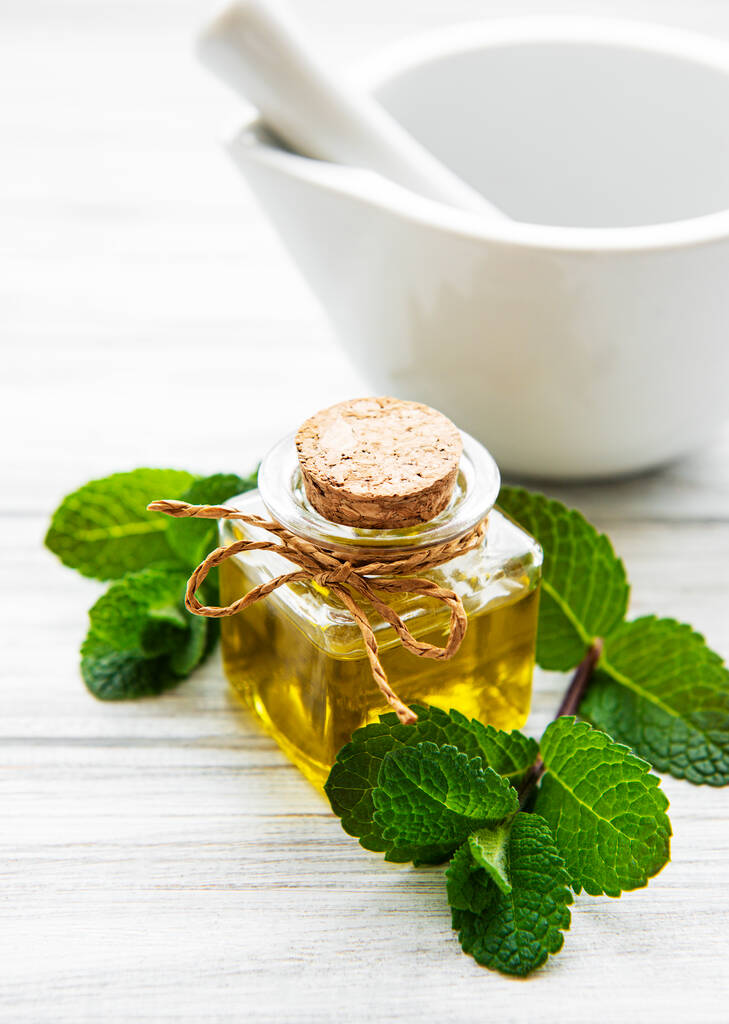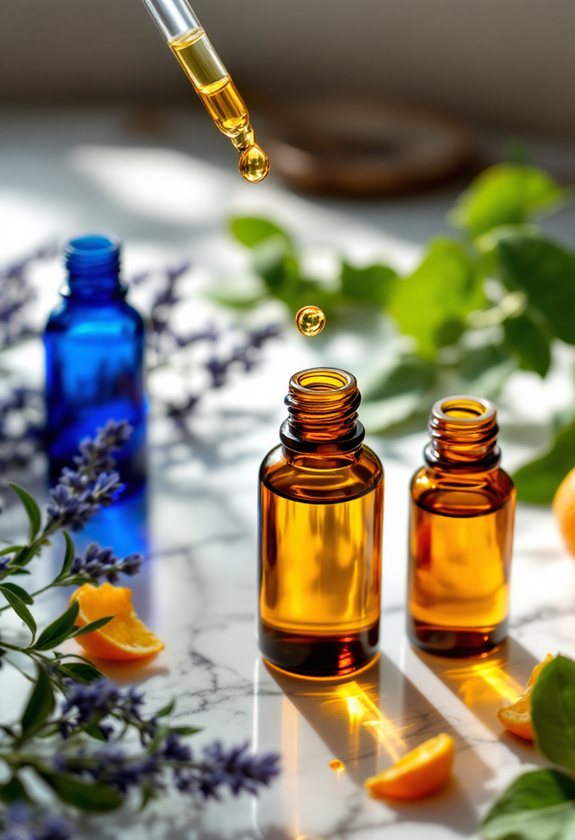Peppermint oil soothes aching muscles because its main active component, menthol, blocks calcium from entering muscle cells, which relaxes tight fibers and reduces spasms. When you apply it, menthol also cools your skin and dulls pain signals by desensitizing nerve endings, offering fast relief. Its anti-inflammatory effects calm down irritated tissues, supporting recovery. Always dilute peppermint oil before use, targeting sore spots only. Learn how proper application and blend choices can enhance your muscle care routine next.
Key Takeaways
- Peppermint oil blocks calcium channels in muscle cells, reducing muscle contractions and promoting relaxation.
- The menthol in peppermint oil desensitizes pain receptors, quickly easing muscle soreness.
- It provides a cooling sensation that soothes discomfort and offers mild numbing effects.
- Peppermint oil has anti-inflammatory properties that help reduce swelling and speed up muscle recovery.
- Topical application targets pain directly, making peppermint oil an effective and natural muscle relief option.
How Peppermint Oil Relaxes Muscle Tissue
When you’re looking for natural ways to ease sore muscles, peppermint oil stands out for its direct impact on muscle tissue relaxation. It works through a process called calcium blockade, where it inhibits calcium from entering smooth muscle cells. By blocking these calcium channels, you help decrease the muscle’s ability to contract. This mechanism is similar to certain prescribed muscle relaxants.
Key actions include:
- Reducing both spontaneous and induced contractions in smooth muscle, such as those in the intestines.
- Dampening responses to common neurotransmitters like acetylcholine, histamine, and serotonin.
As Dr. Patel notes, “Peppermint oil’s calcium blockade lessens contractile signals, leading to sustained muscle relaxation.”
This makes it a valuable tool when your goal is to support others in managing muscle discomfort naturally.
The Role of Menthol in Muscle Relief
- Menthol mechanisms include desensitizing nociceptors, which reduces pain perception over time.
- Its chemical structure allows it to interact with GABA receptors, providing mild anesthetic effects.
- Concentration matters—higher menthol content usually means stronger relief.
- Topical use delivers targeted action, minimizing systemic side effects and supporting your goal to help others feel better.
Analgesic Benefits of Peppermint Oil
- Targets pain receptors for rapid relief
- Works synergistically with ethanol to enhance analgesic effects
- Supports muscle and joint pain management
- Complements cooling sensations with deeper relief
- Offers a natural alternative to synthetic analgesics
Anti-inflammatory Properties for Sore Muscles
Although sore muscles often involve pain, inflammation plays a major role in the discomfort you feel after exercise or injury. Peppermint oil targets this inflammation through several anti-inflammatory mechanisms. By blocking calcium channels in muscle cells, it reduces the influx of calcium that triggers both muscle contraction and the inflammatory process. This action helps decrease swelling and redness in affected tissues.
- Menthol in peppermint oil modulates immune cell activity, particularly monocytes, suppressing inflammatory mediators.
- Immune modulation via activation of TRPM8 channels further limits immune-driven inflammation, aiding muscle recovery.
As Dr. J. Lin, an expert in integrative medicine, notes: “Menthol’s dual action on nerves and immune cells makes peppermint oil exceptionally effective for managing muscle inflammation.”
Use it topically for targeted relief.
Comparing Peppermint Oil to Pharmaceutical Muscle Relaxants
When you’re deciding how to relieve sore muscles, it’s crucial to weigh the differences between natural remedies like peppermint oil and pharmaceutical muscle relaxants. A peppermint oil comparison reveals key advantages for those seeking muscle relaxant alternatives with fewer side effects.
Dr. Lisa Green, a clinical herbalist, notes, “Peppermint oil blocks calcium channels, relaxing muscles without the sedation common in prescriptions.” You’ll also appreciate its cost-effectiveness and broad availability.
Peppermint oil relaxes muscles without sedation and stands out for its affordability and easy access compared to prescription options.
Here are some significant differences to take into account:
- Peppermint oil offers fewer side effects than most pharmaceuticals.
- It can be used topically, orally, or through aromatherapy for flexibility.
- Muscle relaxant alternatives like peppermint oil aren’t linked to dependence.
- Peppermint oil comparison shows broader application beyond one condition.
- It’s affordable and accessible for those you serve.
Effects on Gastrointestinal and Skeletal Muscles
For skeletal muscles, you can use peppermint oil topically to help relieve muscle tension and discomfort.
Menthol, its main component, delivers a cooling sensation and may reduce pain perception.
While research is stronger for gut benefits, its anti-inflammatory effects on sore muscles can still be valuable.
Always focus on precise application and monitor responses carefully.
Safety Guidelines and Proper Application
Before you start using peppermint oil for sore muscles, it’s crucial to understand the key safety guidelines and best practices for application.
Carefully follow proper dilution methods—mix a few drops of peppermint oil with a carrier oil, such as coconut or almond, to reduce the risk of skin irritation.
Use targeted application techniques by gently massaging the blend onto sore areas, avoiding sensitive spots like the face or broken skin.
Dr. Lisa Kim, a clinical aromatherapist, advises, “Always patch test diluted oil on a small area initially.”
Limit frequency to prevent overuse, and be mindful of possible allergic reactions or medication interactions.
- Dilute peppermint oil with a carrier oil before skin application.
- Use only a few drops per application.
- Target sore muscle areas, not sensitive skin.
- Patch test before full use.
- Consult a healthcare provider if combining with other treatments.
Choosing the Right Peppermint Oil Formulation
How do you pick the best peppermint oil for sore muscles? Begin by considering formulation types.
Pure peppermint crucial oil delivers intense cooling but must be diluted—try 3–6 drops per tablespoon of carrier oil for safe massage. If you’re serving clients with sensitive skin, choose muscle rub balms or creams, which blend peppermint oil with moisturizing bases and offer gentler, longer-lasting relief.
Oil blends are another excellent choice. “Combining peppermint with eucalyptus or rosemary can amplify both cooling and anti-inflammatory effects,” says herbalist Dr. Jamie Lin.
For quick, targeted relief, opt for roll-ons or sprays, which make application convenient during busy routines. Always check for organic ingredients and transparent labeling to guarantee purity and quality.
Other Essential Oils That Support Muscle Comfort
When you’re looking to improve muscle comfort beyond peppermint oil, several essential oils stand out for their unique benefits. Each oil supports relaxation and recovery, making your care for others more effective. Experts often recommend blending these oils to enhance their therapeutic effects.
- Helichrysum oil: Known for easing muscle spasms and reducing inflammation, it’s a go-to for injury recovery.
- Marjoram oil: This oil relaxes tense muscles and alleviates cramps, thanks to its analgesic and anti-inflammatory qualities.
- Lavender oil: Ideal for calming both the mind and muscles, it also helps relieve pain and inflammation.
- Eucalyptus oil: Its cooling sensation soothes sore muscles and improves circulation during massage.
- Chamomile oils: Both Roman and German types reduce tension and spasms, providing gentle comfort through topical or aromatic use.
Conclusion
To effectively ease muscle aches, apply 2-3 drops of diluted peppermint oil directly to sore areas, massaging gently. According to Dr. Lisa Grant, “Menthol in peppermint oil relaxes muscle fibers and reduces inflammation.” Always do a patch test, and avoid using on broken skin. Remember, peppermint oil isn’t a cure-all, but it’s a practical, natural option to support muscle comfort when used carefully and as directed.



